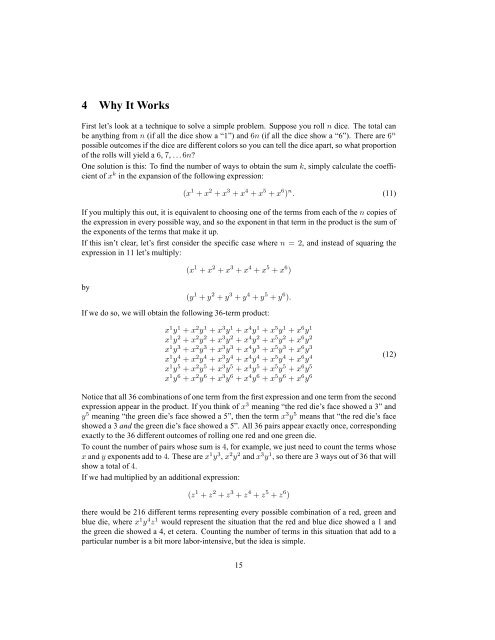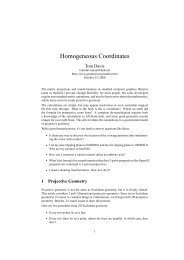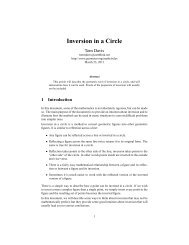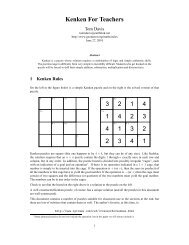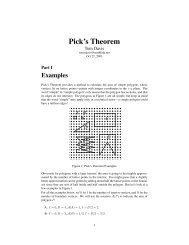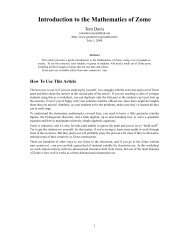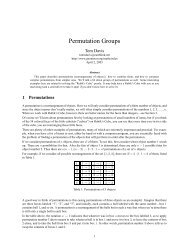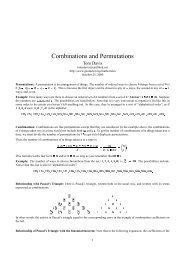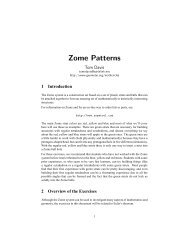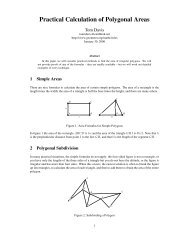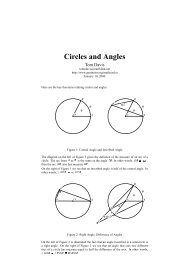P´olya's Counting Theory - Home Page -- Tom Davis
P´olya's Counting Theory - Home Page -- Tom Davis
P´olya's Counting Theory - Home Page -- Tom Davis
Create successful ePaper yourself
Turn your PDF publications into a flip-book with our unique Google optimized e-Paper software.
4 Why It Works<br />
First let’s look at a technique to solve a simple problem. Suppose you roll n dice. The total can<br />
be anything from n (if all the dice show a “1”) and 6n (if all the dice show a “6”). There are 6 n<br />
possible outcomes if the dice are different colors so you can tell the dice apart, so what proportion<br />
of the rolls will yield a 6, 7, . . .6n?<br />
One solution is this: To find the number of ways to obtain the sum k, simply calculate the coefficient<br />
of x k in the expansion of the following expression:<br />
(x 1 + x 2 + x 3 + x 4 + x 5 + x 6 ) n . (11)<br />
If you multiply this out, it is equivalent to choosing one of the terms from each of the n copies of<br />
the expression in every possible way, and so the exponent in that term in the product is the sum of<br />
the exponents of the terms that make it up.<br />
If this isn’t clear, let’s first consider the specific case where n = 2, and instead of squaring the<br />
expression in 11 let’s multiply:<br />
(x 1 + x 2 + x 3 + x 4 + x 5 + x 6 )<br />
by<br />
(y 1 + y 2 + y 3 + y 4 + y 5 + y 6 ).<br />
If we do so, we will obtain the following 36-term product:<br />
x 1 y 1 + x 2 y 1 + x 3 y 1 + x 4 y 1 + x 5 y 1 + x 6 y 1<br />
x 1 y 2 + x 2 y 2 + x 3 y 2 + x 4 y 2 + x 5 y 2 + x 6 y 2<br />
x 1 y 3 + x 2 y 3 + x 3 y 3 + x 4 y 3 + x 5 y 3 + x 6 y 3<br />
x 1 y 4 + x 2 y 4 + x 3 y 4 + x 4 y 4 + x 5 y 4 + x 6 y 4<br />
(12)<br />
x 1 y 5 + x 2 y 5 + x 3 y 5 + x 4 y 5 + x 5 y 5 + x 6 y 5<br />
x 1 y 6 + x 2 y 6 + x 3 y 6 + x 4 y 6 + x 5 y 6 + x 6 y 6<br />
Notice that all 36 combinations of one term from the first expression and one term from the second<br />
expression appear in the product. If you think of x 3 meaning “the red die’s face showed a 3” and<br />
y 5 meaning “the green die’s face showed a 5”, then the term x 3 y 5 means that “the red die’s face<br />
showed a 3 and the green die’s face showed a 5”. All 36 pairs appear exactly once, corresponding<br />
exactly to the 36 different outcomes of rolling one red and one green die.<br />
To count the number of pairs whose sum is 4, for example, we just need to count the terms whose<br />
x and y exponents add to 4. These are x 1 y 3 , x 2 y 2 and x 3 y 1 , so there are 3 ways out of 36 that will<br />
show a total of 4.<br />
If we had multiplied by an additional expression:<br />
(z 1 + z 2 + z 3 + z 4 + z 5 + z 6 )<br />
there would be 216 different terms representing every possible combination of a red, green and<br />
blue die, where x 1 y 4 z 1 would represent the situation that the red and blue dice showed a 1 and<br />
the green die showed a 4, et cetera. <strong>Counting</strong> the number of terms in this situation that add to a<br />
particular number is a bit more labor-intensive, but the idea is simple.<br />
15


